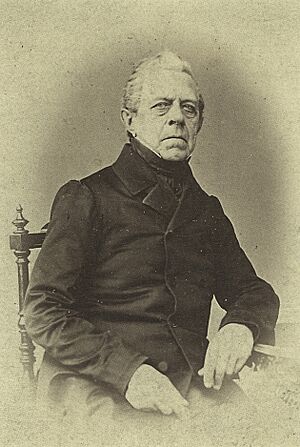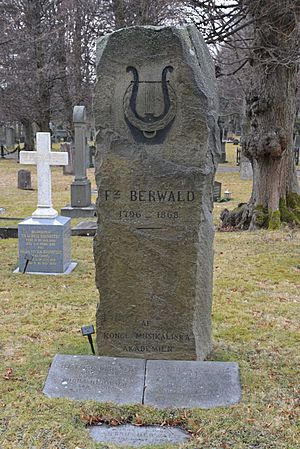Franz Berwald facts for kids
Franz Adolf Berwald (born July 23, 1796 – died April 3, 1868) was a famous Swedish Romantic composer. He wrote beautiful music, but during his life, he wasn't very well-known for it. To earn money, he worked as a doctor who fixed bones (an orthopedist). Later, he even managed a sawmill and a glass factory! People started to truly appreciate his music only after he passed away.
Contents
Life and Music
Berwald was born in Stockholm, Sweden. His family had been musicians for four generations! His dad was a violin player in the Royal Opera Orchestra. He taught Franz how to play the violin when he was very young. Franz even started playing in concerts soon after.
In 1809, King Karl XIII came to power and brought back the Royal Chapel. The next year, Berwald started working there. He played the violin in the court orchestra and the opera. He also began to compose his own music. During the summers, when the orchestra was off, Berwald traveled around Scandinavia, Finland, and Russia. He wrote a septet and a serenade during this time, which he still liked years later.
In 1818, Berwald started a music magazine called Musikalisk journal. It later changed its name to Journal de musique. This magazine featured easy piano pieces and songs by different composers, including some of his own. In 1821, his Violin Concerto was played for the first time by his brother August. But the audience didn't like it much; some people even laughed during one part!
After his father died in 1825, his family faced tough times financially. Berwald tried to get help, and the King gave him a scholarship. This allowed him to study in Berlin, Germany. There, he worked hard on writing operas, even though he couldn't get them performed. To make money, Berwald opened a clinic in Berlin in 1835. It was a place for orthopedic and physiotherapy treatments. This clinic became very successful. Some of the special devices he invented for fixing bones were still used many years after he died.
Berwald stopped composing music while he was in Berlin. He only started again in 1841 when he moved to Vienna, Austria, and married Mathilde Scherer. In 1842, a concert of his tone poems (music that tells a story) was held at the Redoutensaal in the Hofburg Imperial Palace. The reviews were very positive! Over the next three years, Berwald wrote four symphonies. These weren't his first symphonies, as many of his earlier works from the 1820s are now missing.
His Symphony No. 1 in G minor, called "Sérieuse" (meaning "Serious"), was the only one of his four symphonies played during his lifetime. It was first performed in Stockholm in 1843. His cousin, Johan Frederik, conducted the Royal Opera House Orchestra. At the same concert, his short opera Jag går i kloster (I enter a monastery) was also performed. Its success was mainly because a famous singer named Jenny Lind sang in it. In 1846, Lind also sang in one of Berwald's cantatas (a type of vocal music). Another short opera, The Modiste, was less successful in 1845.
Berwald finished his Piano Concerto in 1855. It was meant for his piano student, Hilda Aurora Thegerström. But the concerto wasn't played until 1904! Berwald's granddaughter, Astrid, performed it at a student concert in Stockholm. This piece, especially its exciting last part, is often compared to music by famous composers like Robert Schumann or Edvard Grieg. All three parts of the concerto are played without a break.
During his life, Berwald's music wasn't very popular in Sweden. He even got bad reviews in newspapers. However, his music was a little more liked in Germany and Austria. The Mozarteum Salzburg in Austria made him an honorary member in 1847.
When Berwald returned to Sweden in 1849, he managed a glass factory. It was located at Sandö in Ångermanland and owned by Ludvig Petré, who was also a violin player. During this time, Berwald focused on writing chamber music, which is music for a small group of instruments.
One of his few operas to be performed during his life was Estrella de Soria. It was greatly cheered at its first performance at the Royal Theater in April 1862. It was played four more times that same month. After this success, he wrote Drottningen av Golconda (The Queen of Golconda). This opera was supposed to be performed in 1864, but it wasn't, because the Royal Opera got a new director.
In 1866, Berwald received the Swedish Order of the Polar Star. This was a special award for his musical achievements. The next year, the Royal Musical Academy wanted to make Berwald a professor of musical composition at the Stockholm Conservatory. But the Conservatory Board changed their minds a few days later and chose someone else. The royal family stepped in, and Berwald finally got the job. Around that time, he also received many important requests to write music. Sadly, he died before he could finish all of them.
Berwald passed away in Stockholm in 1868 from pneumonia. He was buried in the Norra begravningsplatsen (Northern Cemetery) there. The second part of his Symphony No. 1 was played at his funeral.
Ten years after Berwald's death, his Symphony No. 4 in E-flat major, called "Naïve", was played for the first time in 1878. It was supposed to be played in Paris in 1848, but that was canceled because of political problems. This wait was short compared to what happened with his Symphony No. 2 in D major, "Capricieuse", and Symphony No. 3 in C major, "Singulière". Those two pieces weren't performed until 1914 and 1905, respectively!
A Swedish conductor and composer named Ulf Björlin has recorded many of Berwald's works.
How People Saw His Music
Eduard Hanslick, a writer in 1869, said that Berwald was "stimulating, witty, prone to bizarrerie," but "lacked creative power and fantasy" as a composer. However, other composers like Ludvig Norman, Tor Aulin, and Wilhelm Stenhammar worked hard to make Berwald's music known. Even with their efforts, it took a while for Berwald to be recognized. Eventually, composer and critic Wilhelm Peterson-Berger wrote in a Stockholm newspaper that Berwald was Sweden's "most original and modern composer."
In 1911, Carl Nielsen wrote about Berwald, saying that "good Art" will always find artists who "forge ahead and produce and stand up for their works." He added that Berwald was "the finest example of this" in Sweden. More recently, in 1959, a British music expert named Robert Layton wrote the only English book about Berwald's life. He also wrote a lot about Berwald's music.
Franz Berwald is known for writing sonata movements (parts of a musical piece) in unusual ways. Music expert Harold Truscott said that Berwald's unusual ideas were always logical and actually helped the music's shape and feeling.
Paul Griffiths noted that Berwald's E-flat major String Quartet achieved "a new formal shape." This was quite remarkable, even if other composers like Liszt or Schumann had more tightly connected single-movement pieces.
Works
Here are some of the musical pieces Franz Berwald composed:
Symphonies
- Symphony in A (Fragment) (1820)
- Symphony No. 1 in G minor (Sinfonie sérieuse) (1842)
- Symphony No. 2 in D (Sinfonie capricieuse) (1842)
- Symphony No. 3 in C (Sinfonie singulière) (1845)
- Symphony No. 4 in E flat (Sinfonie naïve) (1845)
Concertos (Music for Solo Instrument and Orchestra)
- Theme and Variations in B flat for Violin and Orchestra (1816)
- Concerto in E for 2 Violins and Orchestra (1817)
- Violin Concerto in C sharp minor (1820)
- Konzertstück in F for Bassoon and Orchestra (1827)
- Piano Concerto in D (1855)
Other Orchestra Music
- Tone poems (music that tells a story or describes something)
- Slaget vid Leipzig (The Battle of Leipzig, 1828)
- Elfenspiel (Elf Play, 1841)
- Ernste und heitere Grillen (Serious and Cheerful Whims, 1842)
- Erinnerung an die norwegischen Alpen (Memory of the Norwegian Alps, 1842)
- Bayaderen-Fest (Bayadere Festival, 1842)
- Wettlauf (Race, 1842)
- Fugue in E flat (1841)
- Stor polonaise (Grand Polonaise, 1843)
Chamber Music (for Small Groups of Instruments)
- Duo for Violin and Piano in D (1857–60)
- Duo for Cello (or Violin) and Piano in B flat (1858)
- Duo Concertante for 2 Violins in A (1816)
- Piano Trio in C (1845)
- Piano Trio No. 1 in E flat (1849)
- Piano Trio No. 2 in F minor (1851)
- Piano Trio No. 3 in D minor (1851)
- Piano Trio No. 4 in C (1853)
- String Quartet No. 1 in G minor (1818)
- String Quartet No. 2 in A minor (1849)
- String Quartet No. 3 in E flat (1849)
- Quartet in E flat for Piano, Clarinet, Horn and Bassoon (1819)
- Piano Quintet No. 1 in C minor (1853)
- Piano Quintet No. 2 in A (1850–57)
- Septet in B flat for Clarinet, Horn, Bassoon, Violin, Viola, Cello and Double Bass (1828)
- various piano pieces
Vocal Works (Music for Voices)
- Kantat i anledning av högtidligheterna (Cantata for the Celebrations, 1821)
- Serenade for tenor and chamber ensemble (1825)
- Kantat författad i anledning av HKH Kronprinsessans ankomst till Sverige och höga förmälning (Cantata for the Arrival and Wedding of HRH the Crown Princess in Sweden, 1823)
- Gustaf Adolph den stores seger och död vid Lützen (Gustaf Adolph the Great's Victory and Death at Lützen, 1845)
- Nordiska fantasibilder (Nordic Fantasy Pictures, 1846)
- Gustaf Wasas färd till Dalarna (Gustaf Vasa's Journey to Dalarna, 1849)
- Apoteos (Apotheosis, 1864)
- other choral works and songs
Stage Works (Operas and Operettas)
- Leonida, opera (1829, lost)
- Jag går i kloster, operetta (1843; first performance 1843)
- Modehandlerskan, operetta (1843; first performance 1845)
- Ein ländliches Verlobungsfest in Schweden, cantata (A Rural Engagement Party in Sweden, 1847)
- Estrella de Soria, opera (1841/48)
- Drottningen av Golconda (The Queen of Golconda), opera (1864)
Work for Wind Orchestra
- Revue-Marsch (Review March)
See also
 In Spanish: Franz Berwald para niños
In Spanish: Franz Berwald para niños




